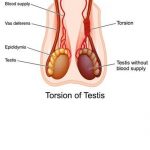TESTICULAR TORSION (THE TWISTING TESTICLES)- AN ACUTE TESTICULAR EMERGENCY
What is testicular torsion?
Mariam Webster defined torsion as “the twisting of a body part on its own axis”. ‘Body part’ in this context are the testicles(AKA testes) and the ‘axis’ are the spermatic cords. In essence, testicular torsion is the twisting of the testicles on the spermatic cords. It is also known as acute scrotum
Wait!! We need to shed more light on the definition in the preceding paragraph.
Embryologically, the testicles developed from the back (very close to the kidneys) and later migrate downwards into the fleshy sac that sits comfortably between the laps of men — the scrotum. This migration is complete shortly before or after birth. (Albeit, it can take up to four years after birth in few cases.) After the descent, the testes get attached to the wall of the scrotal sac for stability sake.
However, the testes are still connected to their site of origin by a rope-like structure called the spermatic cords. The cord also contains blood vessels which supply nutrients to the testes.
(As a reminder, testicular torsion occurs when the testes twist on the spermatic cords.)
Why would the testes twist around the cord?
When the testes are not firmly attached to the wall of the scrotum, they become freely mobile and unstable. This condition is called the ‘bell clappers deformity’. When the twist is severe enough to cut-off blood supply to the testes, pain and swelling ensue.
Rarely, trauma, rigorous sex, rigorous physical activity and malignancy can cause a twist or trigger one in people who are at risk.

Credit: Trinidad and Tobago Newsday
Who are the people at risk?
Testicular torsion is a rare clinical entity with an incidence of 1 in 4,000. Usually occurs among adolescents between the ages of 12 and 18. Can also occur in newborns when the testes are yet to be fully attached to the scrotal sac. Extremely rare after the age of 30. Those with previous torsion testes are at risk.
What are the signs and symptoms?
Severe, unilateral(usually left) scrotal pain of sudden onset
Scrotal swelling and induration
Nausea and vomiting
Elevated testis
Fever, painful urination and urinary frequency have also been reported but uncommon
Diagnosis
Your doctor will make the diagnosis of torsion testes from the clinical evaluation of your scrotum and interview in order to get salient history from you. You may be required to do certain tests like urine test, scrotal ultrasound (scan) to confirm the diagnosis. However, the definitive diagnosis of testicular torsion is surgery (scrotal exploration). Here, your Urologist may have to open up the scrotal sac with minimal incision in order to physically examine the affected testes. Scrotal exploration is also curative.
What are complications of torsion testes?
1. Testicular death or gangrene: the twisting of the testes on its spermatic cord cut-off its blood supply leading to its death or gangrene. A gangrenous testicle appears black and non-viable.
2. Infertility: The death of your testicle may lead to your inability to father a child later in life.
3. Recurrence: An episode or a history of torsion testes puts the same testes or the the other testicle at risk of future twisting. This however taken care of during treatment by your Urologist.
How can it be treated?
Manual detorsion — the affected testis is gently rotated to untwist the torsion. If this does not work then surgery becomes an absolute necessity.
Surgery (orchidopexy and orchidectomy) — the definitive treatment. This involves attaching the testes to the wall of the scrotum after detorsion. The procedure is called orchidopexy. Prolonged(>24h) torsion can lead to irreversible damage of the testes, which require complete removal of the damaged testicle. The procedure is called orchidectomy.
Adjunct therapy may include:
-pain relievers,
-anti emetics,
-anxiolytics.
In conclusion, torsion testes is an acute testicular emergency that requires immediate intervention in order to preserve the affected testicle and save you from future form of male infertility.
This article is the intellectual property of:
Olatunji Teslim Olayinka
(MBBS, College of Medicine, University of Lagos, Nigeria)
Further Reading





















